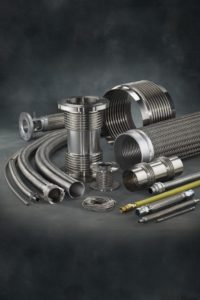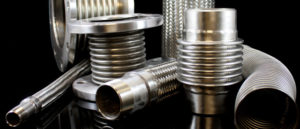 Amazon Hose & Rubber Company is the Premier Distributor for Hose Master, the leading manufacturer of metal hose and expansion joint products throughout the United States and Canada. Through our extensive training with Hose Master, Amazon Hose wants to share with our customers the “8 Factors for When To Use Metal Hose.” We want to thank Rich Troyer from Hose Master for providing this valuable information.
Amazon Hose & Rubber Company is the Premier Distributor for Hose Master, the leading manufacturer of metal hose and expansion joint products throughout the United States and Canada. Through our extensive training with Hose Master, Amazon Hose wants to share with our customers the “8 Factors for When To Use Metal Hose.” We want to thank Rich Troyer from Hose Master for providing this valuable information.
8 Factors for When To Use Metal Hose
There are many different types of hose available on the market. They include metal, rubber, composite, PTFE and fabric. Typically, metal hose is used when no other (non-metallic) construction will work. In other words, metal hose is used as a last resort. The decision of which hose type to buy depends on the application for which the hose is being used. Generally, there are eight factors that should alert you to consider using metal hose:
1. Temperature Extremes
If either the temperature of the media going through the hose or the surrounding atmospheric temperature is very cold or hot, metal may be the only material that can withstand the temperature extremes.
Metal hose can handle a wider variety of chemicals than most of the other hose types. If the hose will be exposed to aggressive chemicals (either internally or externally), metal hose should be considered. Stainless steel exhibits good resistance to many common chemicals and special alloys may be used for added corrosion resistance. (add chlorsafe info and link to that page on site) Please note that special care should be taken to make sure that all assembly components are resistant to chemical attack, both from the media conveyed and the environment.
3. Permeation Concerns
Non-metal hose is susceptible to having gases permeate through the hose wall and into the atmosphere. Metal hose, on the other hand, does not allow permeation when properly fabricated. If containing the gases inside the hose is important, metal hose may be required.
4. Potential for Catastrophic Failure
When a metal hose fails, it usually develops small holes or cracks. Other hose types tend to develop larger cracks or come apart completely. In non-metallic hoses, barbed fittings are typically held onto the hose ends using clamps or crimped collars. Because fittings are welded to metal hose, fitting retention problems are nearly non-existent. If a sudden failure of the hose can be catastrophic, a metal hose may help minimize the effects of a failure by leaking product at a slower rate.
5. Abrasion and Over bending Concerns
To prevent abrasion and over bending, a metal hose can be used as a protective cover over wires or even other hoses. Stripwound hose can be very abrasion resistant, making it ideal for use as protection to corrugated hose from either abrasive media or external damage. Stripwound hose can also be applied to the outside of a corrugated hose to prevent it from overbending. Bending a corrugated hose is one way to excessively fatigue the metal hose of an assembly. However, stripwound hose cannot be overbent without pulling the hose apart, making it an excellent bend restrictor when installed on a corrugated assembly.
6. Fire Safety
Other hose types will melt when exposed to fire while metal hose maintains its integrity up to 1200º F. Flexible corrugated hoses are usually all-metal (unless a fitting contains a non-metallic seal), which makes them naturally fire-resistant. Low permeation and fire resistance make corrugated hoses the preferred choice for barge loading and unloading applications, or any application where the hose may be exposed to an open flame.
7. Achieving Full Vacuum
Under full vacuum, metal hose maintains its shape while other hose types may collapse. The corrugations in a metal hose give it excellent hoop strength, which gives it the ability to handle a full vacuum. Nonmetallic hoses must use helix wires to improve their vacuum rating, but collapse is still possible.
8. Flexibility in Fitting Configuration
Any weld-able fitting can be incorporated into a corrugated hose assembly, and in any configuration, while other hose types require special shanks and collars. This can be a benefit over other hose types that would require multiple threaded connections to connect several hoses together. Every threaded connection is a potential leakage point, so every welded fitting eliminates a leakage point and can facilitate installation.
So, even though the application may not demand the use of a metal hose, there may be times metal will offer the versatility required for your project. Whether you are in need of Metal hoses, Expansion Joints, Industrial hoses, Hydraulic hoses or any other flexible connectors contact one of our Hose Specialists at Amazon Hose & Rubber Company. Visit us at www.AmazonHose.com or call us at (800) 506-5514.
